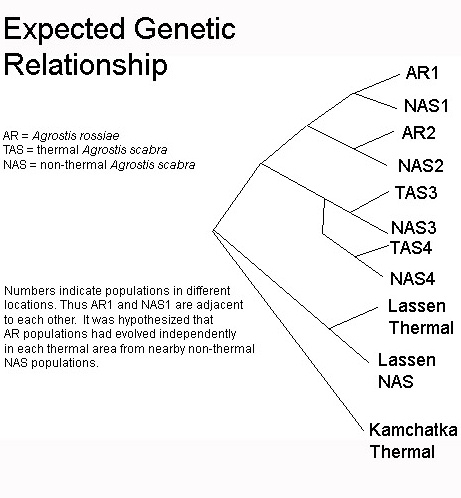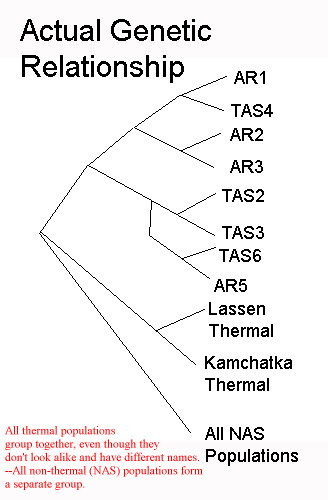
|
Ecology and evolution of plants that are endemic to geothermally heated soils in Yellowstone and Kamchatka.
|
|||||||||
|
Funding Provided By: The Wyoming Native Plant Society US EPA Science to Achieve Results (STAR) Fellowship The National Park Service Loyola University - New Orleans |
Peer-Reviewed Publications: Tercek, M.T., D. P. Hauber and S.P. Darwin. 2003. Genetic and historical relationships among geothermally adapted Agrostis of North America and Kamchatka: evidence for a previously unrecognized, thermally adapted taxon. American Journal of Botany 90:1306-1312. (view pdf) Tercek, M.T. and J.L. Whitbeck. 2004. Heat avoidance life history strategy controls the distribution of geothermal Agrostis in Yellowstone. Ecology 85(7):1955-1966. (view pdf) |
||||||||
 |
Summary: Agrostis rossiae (AR) ("Ross' Bentgrass") is endemic to Yellowstone's thermal areas, and Agrostis scabra ("Tickle Grass") occurs in both thermal and non-thermal habitats. When A. scabra occurs in the thermal areas, we refer to it as "Thermal A. scabra" (TAS) because it assumes an uncharacteristic annual life history, is shorter than normal (8-15cm rather than 20-30cm) and thus differs in appearance from AR only in its spreading rather than compressed flowering stalks. ENLARGED PHOTOGRAPHS OF THESE PLANTS Thermal areas usually only contain one of these thermal Agrostis species --either AR or TAS, but not both (see diagram, left).. Our research originally focused only on AR. We were trying to determine why it only grows in a small part of Yellowstone, in some of the thermal areas but not all of them. But during the first season of field work, we noticed something interesting: thermal Agrostis populations (either AR or TAS) are always surrounded by a non-thermal population of A. scabra (NAS) that is reproductively isolated by its later flowering time. (See the diagram). Remember that the non-thermal plants (NAS) are taller and perennial (grow during multiple seasons instead of just one season). We later did some experiments in the greenhouse which confirmed that these morphological differences between AR, TAS, and NAS are under genetic control. They are not environmentally induced. In habitats that contain a large number of fumaroles (steam vents), the plants exhibit a complex pattern of distribution, but we found a number of "ideal populations" that contain only one fumarole and have a nice, concentric distribution pattern as shown in the diagram (left).
|
||||||||
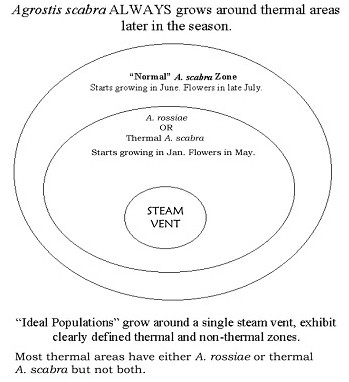 |
|||||||||
|
It was surprising to see such a contrast between plant groups occurring over such a short distance. (The transition zone between thermal and non-thermal populations is about one meter wide). Agrostis species are best known for their use on golf courses, and they are notoriously difficult to distinguish from each other. Who really looks at the grass on a golf course? In fact, botanists have been complaining that they all look alike for hundreds of years. But here in Yellowstone, there are two visually distinct species of plants from this confusing group growing near each other in a consistent pattern. So, just to clarify and repeat the names of the players. . .There are two thermal species (AR and TAS) that grow nearest to the steam vents. These plants are short annuals. There is also a tall, non-thermal perennial species (NAS) that grows concentrically around the thermal species in cooler areas. Got it? Unlike most grasses in this group that look alike, these species are easily identified by field characterstics, and they don't seem to interbreed even though they are only a few feet apart. If you look in a plant identification book for Yellowstone, you will not find any distinction between TAS (one of the short annuals) and NAS (the cool perennial), even though these physical differences remain when the plants are grown in the greenhouse. In other words, after our first field season, we thought that we had discovered a new thermal species that was mistakenly lumped in with NAS. |
|||||||||
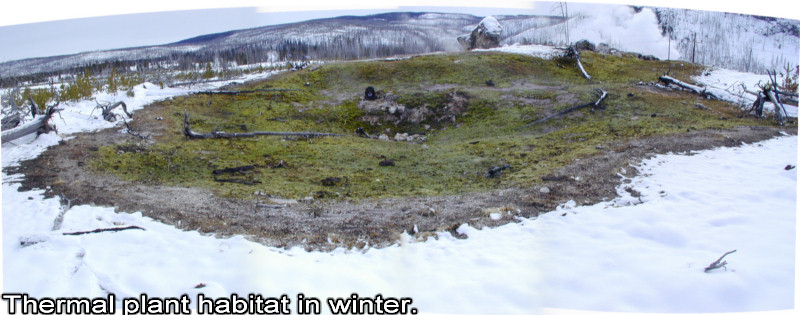 |
|||||||||
|
After spending some time in the library, we discovered that Agrostis species are actually quite famous for something else -- they quickly speciate (form new species) when they grow on sharply contrasting soil types. Patterns similar to the one depicted in the diagram (above) have been observed among Agrostis that grow on soils contaminated by mine tailings (e.g. lead mines). Plants growing on the lead look different than plants growing in normal soil, even though the two groups grow only a few feet apart. The two groups of plants are still able to exchange pollen, but all of their offspring die because they are unsuited to live either in the contaminated or the uncontaminated habitat. They have inferior "intermediate" physiological traits which make them a target of natural selection. Previous researchers have found that genetically distinct populations ("ecotypes") can form in less than 300 years. It seemed like the same thing must be happening in Yellowstone. But in this case, the difference in flowering time (spring for the thermal plants, summer for the non-thermal) indicated that unusually rapid genetic differentiation was taking place. It SEEMED possible that "sympatric speciation" -- a rare phenomenon in plant evolution -- had taken place between the thermal and non-thermal plants. The thermal populations, in other words, seemed to be the evolutionary descendants of the wide-spread NAS. |
 |
||||||||
|
So, there were two basic questions: (1) what is the evolutionary relationship between the thermal and non-thermal populations, and (2) --a modification of the original question in our study-- which environmental factor(s) separates the thermal and non-thermal populations. And why do the thermal plants only grow in the thermal areas? Is that three questions? To answer question #1: We did a genetic study. Jennifer Whipple (NPS botanist, an expert on Yellowstone flora) was invaluable in helping me locate plant populations. We also consulted a number of herbaria (plant museums), and after a lot of hiking, collected all but one of the non-thermal Agrostis species that occur in Wyoming and Montana. Along the way, we obtained a specimen of a thermal Agrostis species that grows in The Valley of the Geysers, in Kamchatka, part of the Russian Federation (thanks to Ann Deutch and Tom Houghman - NPS), and we collected another thermal species from Lassen Volcanic National Park in California. |
|||||||||
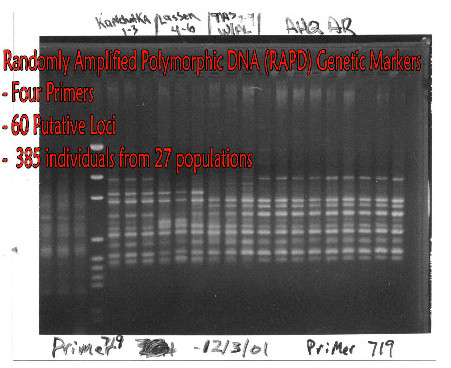 |
The Result: our initial hypothesis concerning the evolutionary relationship of these species was wrong. NAS is not closely related to the thermal populations. Instead, we found that the thermal populations from Yellowstone, California, and Kamchatka were all very closely related to each other. They seem to comprise a previously unrecognized thermal species. This is actually a much more interesting result than we had anticipated. The books that people use to identify plants will have to be changed. Remember, we said that currently plant ID books lump TAS and NAS together? Well, not only are these separate from each other, it turns out that AR and TAS are actually closely related even though these two plants have been thought to be quite different in thr past. For more detail, read the American Journal of Botany publication cited above.
|
||||||||
|
|||||||||

